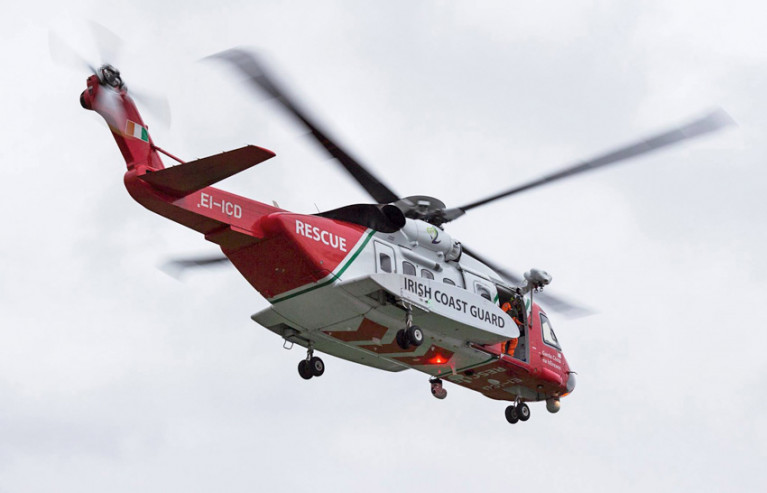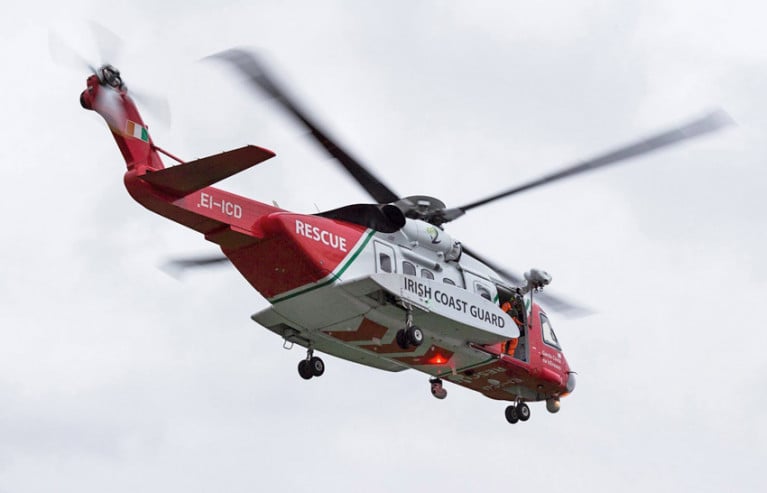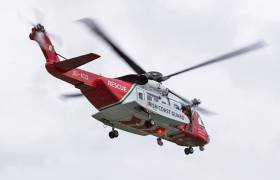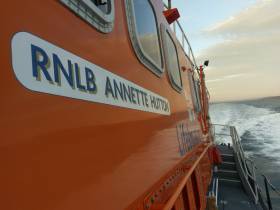Displaying items by tag: Rescue 115
Irish Coast Guard Rescue 115 Helicopter Crew Gives a Flying Lesson
The Irish Coast Guard Rescue 115 search and rescue helicopter team has sought to enlighten people on one frequently asked question about its flying techniques.
A video posted on its Facebook page aims to explain why the helicopter lifts off the ground, rises to ten feet and drops down – a little like a yo-yo on a string- before climbing for departure.
The video demonstrates what the air crew describe as the “standard bounce into ground effect”.
It was recorded as the Sikorsky S-92 helicopter took off from the Aran island of Inis Meáín for University Hospital, Galway.
“This is where you see us hover the helicopter, then drop her low before applying power and departing,” the post says.
“ What happens is rotorwash at the lower height, coupled with the cantered blades, gives extra lift,”the crew says.
“On the way up, a certain power is applied and the aircraft will lift vertically to a height that allows safe flight away from obstacles,”it says.
“ In the event of an engine failure before forward flight, the aircraft would land back on the pad/ground safely, and if the same happened when forward flight is achieved the aircraft would safely fly away,” it explains.
“This is used in helicopter sites that are near big buildings/confined areas for safe operations to the aircraft, and the people or buildings around the site,”it says.
View the video below
A crew member on a Spanish fishing vessel who fell ill with a suspected stroke was airlifted in an operation off the South West Coast on Thursday (2 December), as TheJournal.ie reports.
The Irish Coast Guard’s Shannon-based helicopter Rescue 115 was called to the vessel some 80 nautical miles off Castletownbere for the medevac on Thursday afternoon.
Due to poor weather in Cork and Tralee, the casualty — once winched aboard — was flown to Shannon Airport for transfer by ambulance to University Hospital Limerick for further treatment.
 Rescue 115’s winchman on the deck of the Spanish fishing vessel for the medevac on Thursday | Credit: Rescue 115/Facebook
Rescue 115’s winchman on the deck of the Spanish fishing vessel for the medevac on Thursday | Credit: Rescue 115/Facebook
“Many thanks to the crew of Rescue 01, an Irish Air Corps Casa maritime patrol aircraft that provided top cover for us,” the coastguard team said in a statement on social media.
TheJournal.ie has more on the story HERE.
Rescue 115’s Philip Wrenn Presented With Billy Deacon SAR Memorial Trophy in London
Irish Coast Guard winchman Philip Wrenn has been presented with the Billy Deacon SAR Memorial Trophy at a ceremony in London this week.
As previously reported on Afloat.ie, the crewman with the Shannon-based coastguard helicopter Rescue 115 was recognised in March for his role in the rescue two two Italian brothers who fell into the Atlantic two-and-a-half years ago.
Wrenn was lowered from the helicopter to pluck Giovanni and Ricardo Zanon from the waters after the incident at Poll na bPéist on Inis Mór in the Aran Islands in February 2019.
The brothers were reunited with Wrenn and winch operator Ciarán McHugh for a documentary that aired on TG4 last year.
More recently, Giovanni and Ricardo returned to Ireland with their family last month to thank Wrenn and the rest of the crew for their efforts.
Wrenn was conferred with the Billy Deacon SAR Memorial Trophy six months ago but coronavirus restrictions delayed the in-person presentation until this week, during a special ceremony at the Palace of Westminster yesterday (Tuesday 14 September).
The trophy is named in memory of late Bristow Helicopters winchman Billy Deacon, who died during a Maritime and Coastguard Agency search and rescue helicopter mission in 1997.
Speaking of Wrenn’s rescue efforts, award committee chair George Rawlinson MBE said: “During this service Phil Wrenn faced considerable personal risk. His calm determined professionalism, and quick-thinking selfless action undoubtably ensured a successful outcome.
“A very courageous and brave act indeed, in saving the lives of both casualties. Huge credit goes to the pilot and crew of the rescue helicopter, whose teamwork and communication skills were vital to ensuring a successful outcome for all.
“Phil’s actions exemplify the risks often faced by search and rescue helicopter crews, and other maritime emergency services, who are always ready to respond to the call for help, even in the most challenging and risky conditions.”
Wrenn also received an inscribed watch from sponsors Breitling at the Air League’s Honours and Awards Reception Ceremony hosted by the House of Commons.
Two Italian brothers rescued after they were knocked into the sea in the Aran Islands have returned to meet the coastguard crew who saved them.
In February 2019, Giovanni and Ricardo Zanon were struck by an unexpected wave at Poll na bPéist on Inis Mór, falling 20 metres off the cliff into the cold Atlantic.
Despite sustaining serious injury — Ricardo Zanon broke his tibia and pelvis in the fall — the brothers survived to tell the tale thanks to the swift actions of the crew of the Irish Coast Guard’s Shannon-based helicopter Rescue 115.
As previously reported on Afloat.ie, Rescue 115’s winchman Philip Wrenn won a prestigious award earlier this year for his role in the rescue.
The Zanon brothers and their parents returned to Inis Mór today (Wednesday 11 August) for the first time since the incident to give thanks to Wrenn and the rest of the crew.
Speaking to RTÉ’s Morning Ireland, Ricardo said of that fateful day: “I just remember a big, huge wave like a grey wall coming towards me and then it was completely dark and I thought I was going to die.”
RTÉ News has more on the story HERE.
Air Corps Put on Standby After Mechanical Issue on Coastguard Helicopter Prompts Sea Crash Fears
The Air Corps was put on standby amid fears that an Irish Coast Guard helicopter would have to ditch in the sea, as The Irish Times reports.
Rescue 115 from Shannon was forced to leave one of its crew with an injured fisherman on a fishing vessel off the Co Kerry coast early yesterday morning, Sunday 4 July, when the helicopter’s systems warned of a mechanical issue.
The Sikorsky S-92 “diverted to land at the nearest suitable location” in line with standard procedure, according to a coastguard spokesperson, and the aircraft landed safely at Valentia half an hour later. The issue has since been confirmed to be a “hard fault” and the helicopter is now back in service.
Earlier today, as reported on Afloat.ie, Rescue 115's crew airlifted to hospital a surfer rescued from the sea off Co Clare.
The Irish Times has more on the story HERE.
Surfer Dies After Incident Off Co Clare
BreakingNews.ie reports that a surfer has died in hospital after he got into difficulty off the Co Clare coast this morning, Monday 5 July.
The Irish Coast Guard’s Kilkee unit and Rescue 115 helicopter from Shannon were among the emergency services to attend the scene at Lough Donnell in Quilty, where off-duty lifeguards in the area helped bring the surfer ashore.
The casualty was subsequently airlifted to University Hospital Limerick in critical condition.
This story was updated at 6.05pm on Monday 5 July.
The Irish Times reports that a 35-year-old man was airlifted to hospital with serious spinal injuries after a diving incident in Co Cork yesterday afternoon (Monday 1 June).
It’s understood that the man was diving from rocks near Nohoval Cove, between Kinsale and Crosshaven, when his foot caught and he landed on rocks.
Kinsale RNLI and gardaí attended the scene along with the Irish Coast Guard, which airlifted the casualty on board the Shannon-based Rescue 115 helicopter to Cork University Hospital.
Elsewhere, the search resumed this morning for a five-year-old boy believed to have fallen from a dinghy on Lough Mask.
RTÉ News reports that gardaí and the coastguard are searching the west side of the lough near Toormakeady in Co Mayo.
The Irish Coast Guard’s Shannon-based helicopter launched to rescue two seriously injured crew from a Dutch supertrawler on Friday morning (6 March), as the Irish Examiner reports.
Rescue 115 was dispatched yesterday to the Zeeland, a 6,000-tonne fishing factory, following the incident overnight some 170 nautical miles west of Loop Head.
With winds reaching storm Force 8 at sea, the decision was made to bring the Zeeland closer to the Shannon Estuary to allow the coastguard helicopter to approach in improved weather conditions.
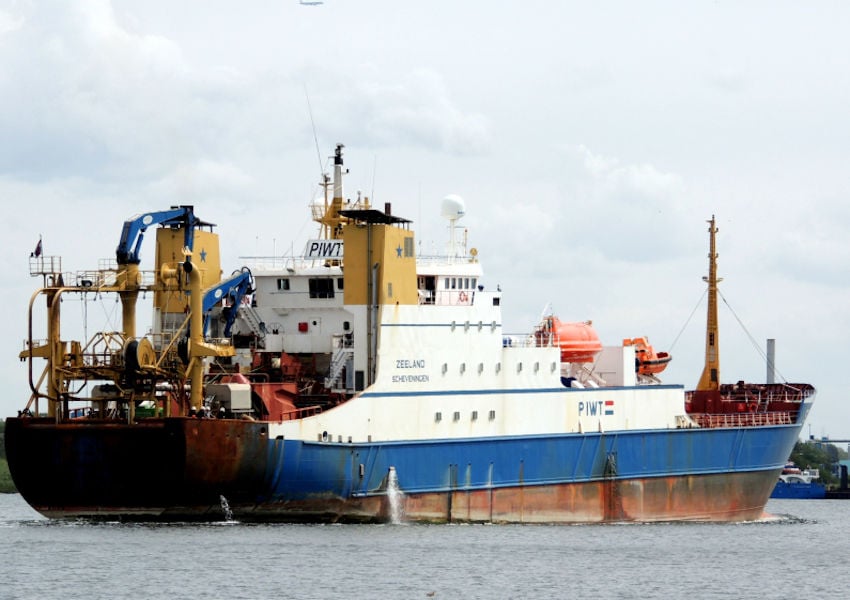 The Zeeland pictured in the Netherlands in 2015 | Photo: Moolen/Shipspotting
The Zeeland pictured in the Netherlands in 2015 | Photo: Moolen/Shipspotting
Both injured crew were assessed and treated on the vessel before being airlifted to University Hospital Limerick. Their condition is not known at this time.
The Irish Examiner has more on the story HERE.
Warnings After Laser Light Strikes Coastguard Helicopter
The Irish Coast Guard has warned over the dangers of laser pointers after a rescue helicopter was targeted during a training operation on Tuesday evening (28 May).
According to TheJournal.ie, Rescue 115 was conducting manoeuvres north of Doolin at around 10.18pm when the green laser light was flashed against the aircraft “multiple times”.
In this instance the flight was not interrupted, but gardaí are investigating and the coastguard has reiterated the dangers of flashing potentially blinding lights at any aircraft.
A recent spate of laser pointer incidents has been reported at Belfast International Airport. TheJournal.ie has more on that story HERE.
Castletownbere’s RNLI lifeboat sprang into action to help locate a tourist reported missing on Dursey Island in West Cork yesterday afternoon (Friday 17 May).
The lifeboat, under the command of coxswain Dean Hegarty, launched shortly after 2pm after Valentia Coast Guard radio received reports that a visitor to the island off the Beara Peninsula had gone missing.
Also tasked were the Shannon-based Irish Coast Guard helicopter Rescue 115, Derrynane Inshore Rescue Boat and the Naval Service vessel LÉ Ciara.
Once on scene, the lifeboat commenced a search of the area while Rescue 115 did a sweep of the island and spotted a person who fitted the description of the casualty.
The coastguard helicopter lowered a winchman and confirmed that the casualty was safe and well. All emergency services were then stood down.
Commenting on the callout, launching authority Paddy O’Connor said: “We are delighted at the very swift response of the crew and that the casualty was located safe and well.”



























